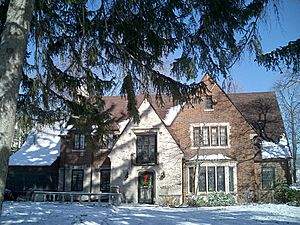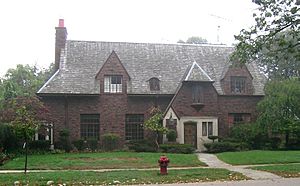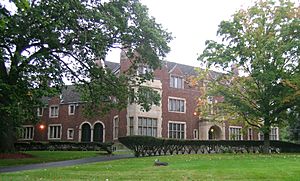Palmer Woods facts for kids
Quick facts for kids |
|
|
Palmer Woods Historic District
|
|

Streetscape along Strathcona Drive
|
|
| Location | Detroit, Michigan, U.S. |
|---|---|
| Built | 1915 |
| Architect | Multiple |
| Architectural style | Colonial Revival, Tudor Revival |
| NRHP reference No. | 83000896 |
| Added to NRHP | August 11, 1983 |
The Palmer Woods Historic District is a beautiful neighborhood in Detroit, Michigan. It is known for its large, elegant homes and tree-lined streets. This historic area is located between Seven Mile Road, Woodward Avenue, and Strathcona Drive. There are about 295 homes in this 188-acre district. It was added to the National Register of Historic Places in 1983 because of its special history and architecture. Many wealthy professionals in Detroit live in Palmer Woods.
Contents
History of Palmer Woods
The Palmer Woods Historic District is named after Thomas W. Palmer. He was an important person in Detroit in the 1800s and a United States Senator. Mr. Palmer owned a lot of land in the area. He gave some of his land to Detroit to create Palmer Park. He also gave land to Michigan for the Michigan State Fairgrounds.
Developing the Neighborhood
Thomas Palmer passed away in 1913. Two years later, a real estate developer named Charles W. Burton bought part of Palmer's estate. This is the land where Palmer Woods is today. Burton wanted to create an exclusive neighborhood for Detroit's wealthiest citizens. He imagined a place with large, elegant homes.
Burton hired a landscape architect named Ossian Cole Simonds. Simonds designed the neighborhood to be very natural and park-like. He created gently curving streets that followed the land's natural beauty. There are no curbs, which makes the lawns seem to flow right into the street. This design also helps keep out extra foot traffic. Each lot in the neighborhood was made to have a unique shape.
Building Homes and Recognition
Many homes in the Colonial Revival and Tudor Revival styles were built between 1917 and 1929. In 1938, the Michigan Horticultural Society gave Palmer Woods an Award of Merit. They called it the finest planned neighborhood in Michigan. More large homes were built after World War II.
In recent years, the neighborhood has continued to thrive. By 2011, the community started its own private security service. This helped keep the area safe. Housing prices, which had gone down for a while, began to rise again by 2014.
Architecture and Design
Palmer Woods is famous for its streets lined with elm trees. The homes are large and made of brick and stone, often in the Tudor Revival architecture style. They are set back from the street, with wide, open lawns. The lots are big, with plenty of space for trees and grass. Many homes have special features like coats of arms, stained glass windows, or even elevators. Some properties have more than one building, such as a main house and a guest house. The streets gently curve through the wooded neighborhood, adding to its charm.
Palmer Woods has its own security service. It also has an active neighborhood association where residents work together. The neighborhood has attracted many important people from Detroit. These include doctors, politicians, business owners, artists, and company executives. Charles W. Burton, who developed the area, also lived there himself.
Famous Residents and Architects
Two of the seven Fisher Brothers, who owned Fisher Body, lived in Palmer Woods. Alfred and William Fisher had homes in the neighborhood. William Fisher's former house, at 1791 Wellesley Drive, is one of the largest in Detroit. It is about 35,000 square feet. Alfred J. Fisher's former mansion is at 1771 Balmoral Drive. John H. Kunsky, who started United Artists theaters, also lived in the area.
Almost every house in Palmer Woods has unique architectural details. Some homes are especially important. At the southern edge of the district is the Dorothy H. Turkel House. This is the only house in Detroit designed by the famous architect Frank Lloyd Wright. C. Howard Crane, a well-known theater architect, designed John H. Kunsky's home. He included many theater-like elements in its design. Other famous architects like Minoru Yamasaki and Leonard B. Willeke also designed houses in Palmer Woods.
The Bishop Gallagher Residence
One of the most important houses in the district is the 62-room Bishop Gallagher residence. It is located at 19366 Lucerne Drive. This large mansion was built in 1925 for the Fisher brothers. They hired a Boston firm called McGinnis and Walsh to design the Tudor Revival building. This firm was known for designing church-related buildings.
After it was finished, the Fisher brothers gave the house to Bishop Michael Gallagher. He was a leader in the Roman Catholic Archdiocese of Detroit. This 40,000-square-foot home is the largest in the city of Detroit.
The house is a two-story brick building with a large center and wings that extend diagonally. It has many exterior sections, each with a decorative top. The house includes religious designs both inside and out. Outside, you can see medallions, shields, and crests in the brickwork. There is also a copper statue of the Archangel Michael defeating Satan. The inside of the house is decorated with oak wood, stone, and other masonry. At one time, it had the largest collection of Pewabic glazed pottery tile in Michigan.
Bishop Gallagher lived in this house until he passed away in 1937. Other archbishops of Detroit, like Cardinals Edward Mooney and John Dearden, also lived there. After Cardinal Dearden's death in 1988, the archdiocese sold the mansion in 1989 to John Salley. He was a basketball player for the Detroit Pistons. In 1995, John Salley sold the property to Bishop Wayne T. Jackson. He used it as his home and for his ministry's offices. In 2017, the mansion was sold again to a real estate developer from California.
Schools in the Area
Palmer Woods is part of the Detroit Public Schools district. Students living in the neighborhood attend Palmer Park Preparatory Academy for elementary and middle school. This school was formerly known as the Barbara Jordan School. All high school students go to Mumford High School. Palmer Park Preparatory Academy is run by teachers.
See also
 In Spanish: Palmer Woods para niños
In Spanish: Palmer Woods para niños




